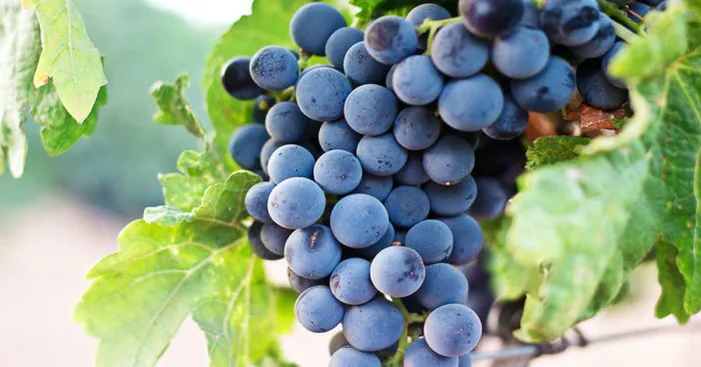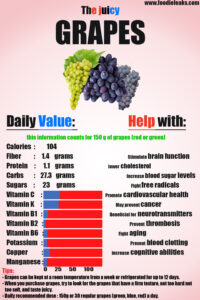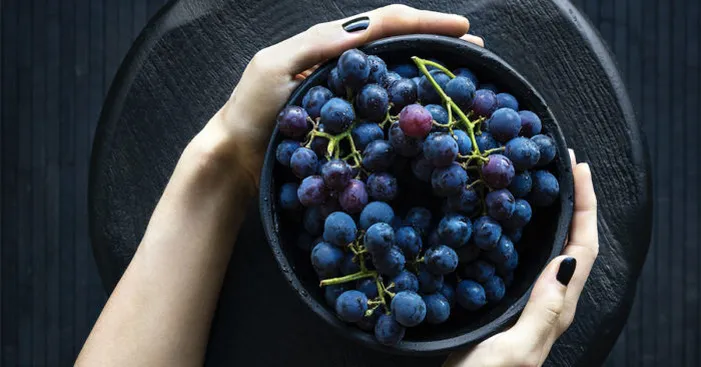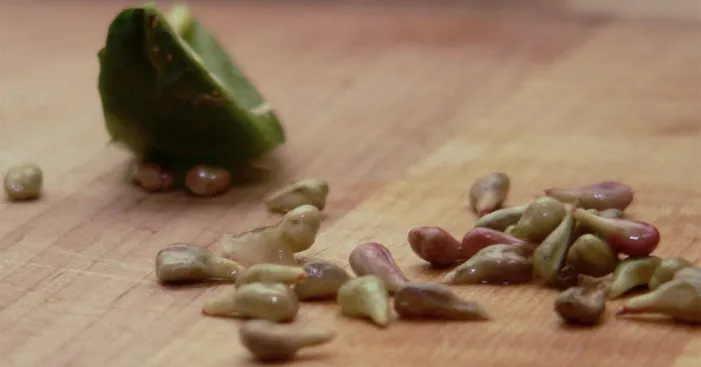Table of Contents

Carbs in grapes come from a variety of nutrients that exist in different proportions depending on the part.
For instance, the seeds contain a specific combination of nutrients that differ from the leaves or the fruits.
Even though, table wine and grapes come from the same plant AKA Vitaceae, there are different types of grapes and each has its use. (1)
Grape as a consumable fruit is usually bigger in size with thin skin and usually doesn’t have seeds.
On the other hand, wine grapes contain seeds that are smaller in size with a fairly thick skin which gives the wine an intense aroma. (2)
Despite the fact that some of the carbs in grapes come from their high sugar content, this fruit has a lot of virtues.
Grapes may as well add health benefits to salads, cereals, and many other healthy recipes.
History of grapes:

Grapes grew first wildly since prehistoric times and evidence suggests that the first cultivations started in Asia about 5000 BC. (3)
Indeed, this fruit is ancient and has even played a role in some biblical stories as the “fruit of the vine”.
In addition, grapes also existed in ancient Egyptian, ancient Greek, and Roman times.
A couple of centuries after, during the 2nd century AD, there were already more than 90 grape varieties across Europe. (4)
Several centuries later, it was not before the 17th century that Spanish settlers planted the first grape plants in the US.
Specifically, they found the best weather in Central Valley- California as it offered a suitable climate with almost no harmful insects. (5)
Do carbs in grapes make you fat?

Generally, most food if eaten in abundance causes weight gain which is a natural response of the body to store excessive fats.
However, with grapes, you get a little number of calories and you have to eat a lot of them to gain weight.
Nonetheless, this is only true when we only take into consideration the calorie intake.
In addition, grapes also contain a high amount of sugar which obviously can cause some weight issues and other health issues.
What we can conclude from that is that portion management is the most effective way to manage your weight.
As long as you enjoy grapes with moderate amounts you have nothing to worry about in terms of weight gain.
In other words, if you eat no more than 3.5 to 4 ounces (100 to 112g) or 13 to 15 grapes a day you won’t gain weight. (6)
Carbs in grapes:
Carbs in grapes: the fruits:

Grapes are among the fruits that are high in carbs and sugar as one grape contains about 1g of carbs. (7)
The carbs of this amazing fruit offer vitamin C, vitamin K, vitamin B1, and vitamin B6.
Vitamin K is very important to maintain bone density and blood clotting.
Nutritional data of grapes (red or green):
The recommended daily intake of grapes is 150g (red or green) and for that, your body will be getting: (8)

- Calories: 104
- Carbs: 27.3 grams
- Protein: 1.1 grams
- Dietary Fibers: 1.4 grams
- Sugar: 23g
- Vitamin C: 5%
- Vitamin K: 18%
- Vitamin B1: 9%
- Vitamin B2: 8%
- Vitamin B6: 8%
- Potassium: 6%
- Copper: 21%
- Manganese: 5%
Using grapes:

There are plenty of ideas to use grapes in your diet, you can use them in:
- Fruit salads: not only add a tangy-sweet flavor to your salad but also add to its decoration.
- Green salad mix.
- Curries: to add a fruity taste to it.
- Chicken salads.
- A snack alongside cheese as they combine well together.
- As a low-calorie snack on their own.
- In any dessert recipe as they will add color and flavorful natural taste similar to syrups.
Carbs in grapes: the seeds

Even more than the fruits, the carbs in grape seeds offer a huge amount of antioxidants and anti-inflammatory properties.
Grape seeds offer a lot of micro-nutrients including vitamins C, B1, B2 and phenols.
These substances offer great antioxidant properties and play a major role in keeping the body free of toxins. (9)
Among those strong antioxidants in grape seeds, we mention mainly rutin, resveratrol, and quercetin.
In addition to antioxidant pigments, grape seeds offer monounsaturated omega 9, omega 6, vitamin E, etc.
According to the NIH, grape seeds are made of 7% phenols, 11% proteins, 16% oil, and 40% fibers. (10)
The different nutrients in grape seeds offer a wide range of health virtues including:
- Maintains cognitive abilities by limiting the formation of cerebral plaque especially for Alzheimer patients.
- Reduces the risk of cancer especially skin cancer as it helps fight free radicals and protects from UV radiation on the skin.
- Promotes the healing of wounds especially when using grape seed extracts in lotions.
- Prevents macular degeneration by improving the irrigation (hydration) of the retina. (11)
- Lowers the blood pressure, promotes blood circulation, and protects the vessels.
- Superior antioxidant properties than that of beta-carotene, vitamin E, and vitamin C.
- Helps fight metabolic syndrome which results in insulin resistance, obesity, excess bad cholesterol, and cardiovascular diseases. (12)
- Reduces aging by reducing stretch marks and wrinkles and also maintains the beauty of the hair.
Using grape seeds:

Grape seeds are maybe not easy to involve in your diets as we usually just get rid of them.
To get the virtues of grape seeds you can start by eating grape as a whole fruit along with its seeds, you may find it difficult to chew through… (13)
There are other easier options though as you can find grape seeds extracts or grape seeds vegetable oil.
Both of these grape seed sub-products may be used as a seasoning for your salad or any recipe of your choice.
You can also add a few drops of grape seed extract to your fruit juice or morning coffee.
Experts recommend using 1 tbsp of grape seeds oil per day for optimal yet safe results. (14)
As for grape seeds oil, you can use it to marinate your barbecue recipe as it combines well with all sorts of meat and fish.
Carbs in grapes: the leaves

When it comes to carbs in grape leaves, you would be stunned by the number of good nutrients that they contain.
Grape leaves are very anti-inflammatory and to include them in the diet means more resistance facing inflammation. (15)
Also, they are also anti-microbial and antioxidant and this is good to face free radicals the cause of most diseases.
Benefits of grape leaves:

A good remedy for varicose veins:
There was a study published in 2004 by the medical journal Drugs R & D which shows the effect of grape leaves extract in both sexes. (16)
Both men and women show to have better micro-circulation in their leg veins.
This seems to reduce the risk of getting varicose veins and even treat an already existent case.
Have a low glycemic load:
A whole serving of grape leaves a day has as low as 1 glycemic index.
Monitoring our daily glycemic index is very important since it is the root of many diseases and especially diabetes.
This is due to the fact that consuming food with a high glycemic index could lead to serious complications.
A healthy GI should not exceed 100 and based on that grape leaves are totally healthy as they only represent 1%. (17)
A good source of magnesium and calcium:
The leaves of a grape tree contain a good amount of minerals and mostly calcium and magnesium.
In just one ounce of grape leaves, you can find more than 8%, 13% and 35% of the daily need in calcium, copper and manganese consequently. (18)
Rich in omega-3 fatty acids:
Surprisingly, grape leaves contain about 2% of fat per serving which is unusual for a vegetable source.
The majority of that comes from omega-3 fatty acids which are beneficial in many ways as they:
- Reduces plaques in the veins.
- Lowers the risk of strokes and heart attack.
- Lowers blood pressure.
Using grapes leaves:

Grape leaves are mainly used in a small Mediterranean dish called Dolmas. (19)
They are basically grape leaf rolls usually filled with rice, meat, and spices according to the desire.
Other parts of the world also use grape leaves with different techniques and fillings.
The idea is very simple as you can use grape leaves after washing them, to roll them on a filling of your choice.
That means this could even be a good choice for vegetarian or gluten-free diets as you can also fill the leaves with salads.
Finally, the idea here is that grape leaves can even substitute aluminum foil for a natural and healthier baking wrap.
Possible side effects of carbs in grapes:

The carbs in grapes are filled with extremely beneficial nutrients but there are some side effects related to overdose consumption.
The benefits of grapes, grape seeds, and grape leaves are only obtained with moderate consumption.
However, an overconsumption may lead to:
Diarrhea:
These fruits are relatively high in fibers and sugars so when you eat too many grapes you may experience diarrhea. (20)
This is because fibers facilitate the movement of the stool in the intestines by absorbing water.
Therefore, too many fibers will result in a more watery stool and that is what we refer to as diarrhea.
Constipation:
Even though we just mentioned how excessive consumption of grapes could lead to diarrhea, it can also cause constipation. (21)
This is because the fibers in grapes are partially insoluble fibers, especially thick-skinned grapes, which makes them hard to digest.
Too many insoluble fibers may cause blockage in the gastrointestinal tract and this would lead to constipation.
Increase in blood sugar levels:
So many studies established that carbs in grapes do contain sugar but if eaten moderately they can benefit diabetic patients. (22)
For people with diabetes, it is all about portions control because they have less tolerant of sudden changes in the body’s indicators.
Therefore, it is best to reach out to your doctor and ask about the safe dosage of grapes to eat and strictly follow that recommendation.
Affects pregnancy:
Consuming large quantities of grapes could lead to serious damage to both the mother and the fetus. (23)
This is because grapes may sometimes contain toxic substances mainly due to the use of an insecticide.
Also, the carbs in grapes may act on the female hormones of the mother during pregnancy which could lead to unexpected side effects.
Allergic reactions:
Grapes allergy falls under a wide group of allergies that goes by the name LTP syndrome. (24)
This group of food also includes apples, peanuts, tomatoes, walnuts…
For someone with an LTP allergy or lipid transfer proteins allergy, eating this fruit could lead to several symptoms such as:
- Nausea.
- Vomiting.
- Headache.
- Hives.
- Swelling of the tongue and lips.
- Anaphylaxis reaction (often needs hospitalization).
References:
(1): Vitaceae | plant family | Britannica
(2): Thick Grape Skins – Reasons For Grapes With Thick Skin (gardeningknowhow.com)
(3): Archaeologists discover 5000-year-old grapes – Lonely Planet
(4): Grapes | Co+op (grocery.coop)
(5): valleysgold-grapes
(6): Grapes For Weight Loss: Can Eating Grapes Help You Lose Weight? Here’s The Answer (ndtv.com)
(7): Are Grapes Keto? Carbs In Grapes + Substitutes | Wholesome Yum
(8): Grapes, raw, red or green (European type, such as Thompson seedless) nutrition facts and analysis. (nutritionvalue.org)
(9): Polyphenolic Contents and Antioxidant Properties of Different Grape (V. vinifera, V. labrusca, and V. hybrid) Cultivars (hindawi.com)
(10): The Study of Antioxidant Components in Grape Seeds – PMC (nih.gov)
(11): Protective effects of a grape-supplemented diet in a mouse model of retinal degeneration – PMC (nih.gov)
(12): Grapes (Vitis vinifera) as a Potential Candidate for the Therapy of the Metabolic Syndrome – PubMed (nih.gov)
(13): Is it good to eat grape seeds? | Vinmec
(14): Is Grapeseed Oil Healthy? All About This Versatile Cooking Oil | Martha Stewart
(15): What Are the Health Benefits of Grape Leaves? | livestrong
(16): Improvement of cutaneous microcirculation and oxygen supply in patients with chronic venous insufficiency by orally administered extract of red vine leaves AS 195: a randomised, double-blind, placebo-controlled, crossover study – PubMed (nih.gov)
(17): What Are the Health Benefits of Grape Leaves? | livestrong
(18): Grape leaves, raw nutrition facts and analysis. (nutritionvalue.org)
(19): What Is Dolma? (with picture) (delightedcooking.com)
(20): Eating too many grapes in one go can be a little risky for you! – Times of India (indiatimes.com)
(21): Eating too many grapes in one go can be a little risky for you! – Times of India (indiatimes.com)
(22): Type 2 diabetes and glycemic response to grapes or grape products – PubMed (nih.gov)
(23): Fruits to Avoid During Pregnancy Diet – Healthy Pregnancy | Apollo Cradle
(24): Severe immediate allergic reactions to grapes: part of a lipid transfer protein-associated clinical syndrome – PubMed (nih.gov)
